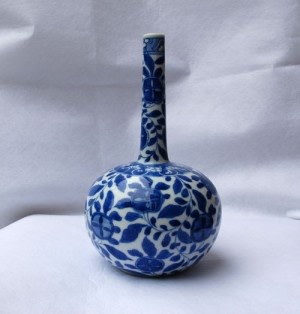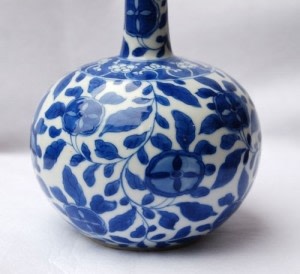With a slightly compressed globular body and tall slender cylindrical neck, painted in shades of bright underglaze blue enamels with on the body dense foliate scrollwork detailed with large stylised lotus flower-heads, the shoulder with a band of white lotus and flower-heads on a blue ground, the foliate scrollwork continuing on the neck and finishing around the rim of the mouth with a band of halved flower-heads on a ground of line-drawn triangle-work, the glazed base decorated with a "G" mark to the centre.
Literature
For an almost identical example see Christiaan J.A. Jorg in collaboration with Jan van Campen, Chinese Ceramics in the Collection of the Rijksmuseum, Amsterdam, published by Phillip Wilson and the Rijksmuseum Amsterdam, London and Amsterdam, 1997, pl 298, p. 259 and for two further very similar examples but in famille verte, pl. 299, p. 260. These bottles are also inscribed on the base with the letter "G".
Another very similar example again with the letter "G" to the base in the Victoria & Albert Museum, museum no: C.784-1910 and two further examples in the British Museum, registration no: Franks.358.+, from the Sir Augustus Wollaston Franks collection.
The shape of the bottles is based on a Western glass model and would have contained spirits. They were probably made in sets. The bottles were very likely ordered by a European who used his initial as a mark of ownership, but the use of the Roman letter "G" inscribed in underglaze blue on the base remains enigmatic. It occurs both on blue and white as well as on famille verte enamelled porcelain. A blue and white punch pot in the collection at Burghley House at Stamford, Lincolnshire, has such a mark. Most examples seen are of very high quality suggesting that this type of "G"-marked ware was of superior grade, custom made perhaps for a discriminating member of the East India Company, a private merchant, or for some elevated individual in England or the Netherlands. There is a famille verte teapot in the Groninger Museum in the Netherlands which also bears this unusual "G"-mark on its base and which is illustrated in Christiaan J.A. Jorg, Famille Verte Chinese Porcelain in Green, Enamels, Groninger Museum, 2011, p. 132, pl. 120.




